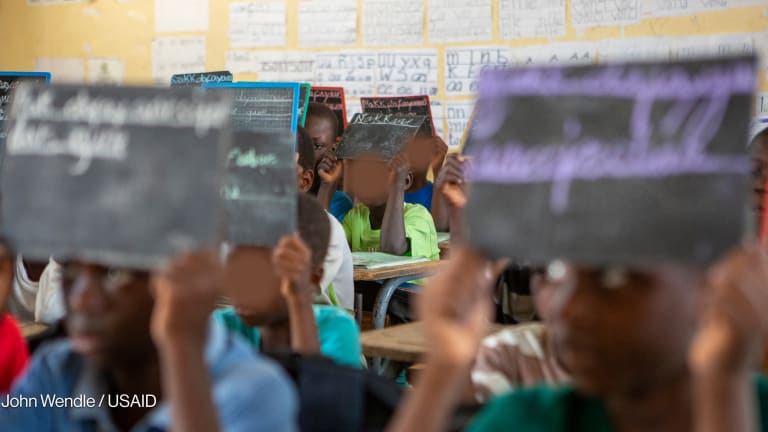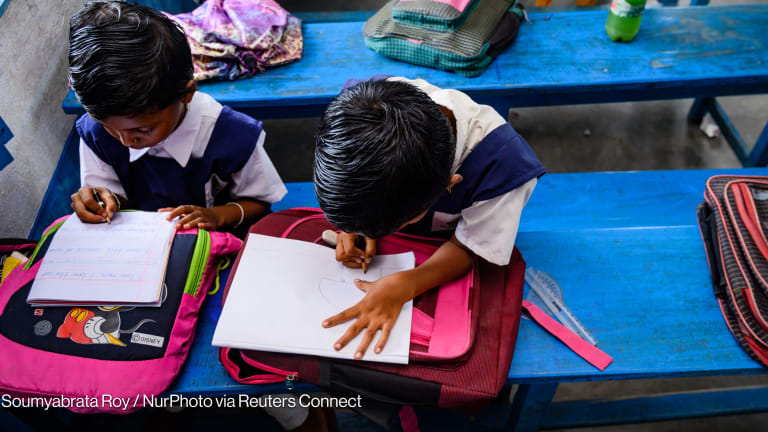
For many children around the world, the school closures resulting from the COVID-19 pandemic have meant nearly two years of no education whatsoever.
That’s because access to remote learning is limited or nonexistent for some of the students who need it most, due to a range of factors including a lack of access to connectivity and affordable devices. These factors cause these students to fall much further behind than their peers.
Now, with a focus on getting kids back in the classroom, experts say it’s critical to focus not just on enrollment and attendance, but also on effectiveness, particularly in low- and middle-income countries where an upward trend in attendance has not always translated to an upward trend in learning.
“The longer kids stay out of school, the more pressing getting them back in is,” said Lant Pritchett, the research director at Research on Improving Systems of Education, or RISE, which focuses on how the education system can overcome the problem of children spending years in school without gaining foundational skills — now widely referred to as “the learning crisis.”
“Having had a break, it would be a great time to introduce a whole bunch of new ways of doing things,” he said, noting the need to assess children as they return to school, formulate a plan to bring them back up to speed, and track their progress.
“My vague sense is we had more consensus about that six months ago than we do today,” Pritchett said.
Up until last year, the global education community had made great progress in increasing attendance and was starting to expand its focus to ensure that kids who were in school were actually learning. COVID-19 has forced 1.6 billion children out of school, and even for those students who could remotely access their education, the experience could not replicate being in a classroom. Now, as schools reopen, some experts are concerned that an emphasis on enrollment will lead some countries to focus on the logistics of school reopenings rather than the need to scale up proven strategies to improve learning outcomes.
“Purely remote instruction does worse on average than hybrid instruction and hybrid instruction does worse on average than in person instruction.”
— Eric Hanushek, 2021 Yidan Prize winnerHelping children catch up before they fall too far behind
While India has made remarkable gains in access to schooling that has not always translated to access to learning, with many children still unable to read or do basic math after years in school.
Pratham Education Foundation, an organization focused on improving the quality of education, uses a technique called Teaching at the Right Level to help students who are behind to catch up.
The approach has scaled throughout India and Africa, helping more than 60 million children to build the foundational skills they need before they leave primary school.
“A lot of the children cannot get on the ladder on time, then the ladder becomes very steep and moves ahead,” said Rukmini Banerji, CEO at the Pratham Education Foundation, during the Yidan Prize Summit earlier this month, where she was recognized for winning the highest accolade in education. “If you start at the level the child is, you can move quickly ahead.”
While Teaching at the Right Level provides an immediate solution, the long-run solution has to do with asking how to develop a curriculum, and an education system that does not leave students behind in the first place, she said.
“In many locations in the Global South, learning levels were low even before COVID and learning trajectories were relatively flat or shallow over time,” Banerji told Devex in a follow-up email. “This is the context in which COVID struck the world.”
Since then, many students have forgotten what they already knew, or did not have the opportunity to learn. So the focus moving forward, she said, needs to be on rebuilding skills, restoring the confidence of children, teachers, and families, and building the capability for more learning in schools. Unfortunately, in many settings, a rigid curriculum gets in the way of figuring out what children need.
Banerji said she is hopeful that the need to draw children back to school could drive new efforts to strengthen learning.
Considering learning as an activity, not a place
In the future, the world should consider learning more as an activity than a place and support it in a range of ways, said Andreas Schleicher, director for education and skills at the Organisation for Economic Co-operation and Development.
Technology can play a critical role in this transition, he said at the Yidan Prize Summit.
As the same kinds of things that are easy to teach and test have also become easy to digitize and automate, schools are waking up to the need to reimagine learning, Schleicher said in a follow-up email to Devex.
“You see more and more people asking questions like: To what extent are our current spaces, people, time, and technology helping or hindering the future of education? Where will modernizing and fine-tuning the system achieve our goals? And where do we need transformation, an entirely different approach to how we configure people, spaces, time and technology in education?” he said.
The importance of teacher effectiveness and local capacity
But the pandemic has illustrated that technology cannot, and should not, replace teachers, and that human interaction is critical.
Opinion: How will countries make up for lost learning during the pandemic?
Catch-up and remedial forms of education have been considered recently due to the time and opportunities children lost in the pandemic. But what type will these be, and how much will they cost?
“The teacher is really important,” said professor Eric Hanushek, who won the 2021 Yidan Prize along with Banerji. He is a fellow at Stanford University and a widely cited expert on the importance of teacher effectiveness. “Purely remote instruction does worse on average than hybrid instruction and hybrid instruction does worse on average than in person instruction.”
If the world returns to the same quality of schools as before COVID-19, the learning losses that students have experienced are likely permanent, he said.
“The first emergency message is getting kids back into school in some manner,” Hanushek told Devex.
But schools cannot remain as they were, particularly in LMICs, and the logistics of reopening schools safely should not completely distract from the fact that schools have to “actually teach kids.”
“There’s some outside hope that as people see the urgency of trying to deal with the losses that the current generation has suffered that they take fixing the schools more seriously,” Hanushek said.
Even if the evidence suggests that an education program will be effective, its success depends on the details of local implementation.
Hanushek plans to use the $3.9 million Yidan prize to start a fellowship for African economists to work with educational researchers in order to conduct evaluations, analyze data, and communicate results.
The goal, he said, is to build capacity in education policy in LMICS, a critical element in scaling education interventions, no matter how well they are designed.








